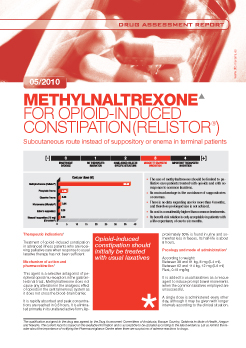
DAR No 5: Methylnaltrexone (Relistor®) for opioid-induced constipation
Subcutaneous route instead of suppository or enema in terminal patients
- The use of methylnaltrexone should be limited to palliative care patients treated with opioids and with no response to common laxatives.
- Its main advantage is the avoidance of suppositories or enemas.
- There is no data regarding use for more than 4 months, and therefore prolonged use is not advised.
- Its cost is considerably higher than common treatments.
- Its benefit-risk relation is only acceptable in patients with a life expectancy of one to six months.
Conclusions:
The use of methylnaltrexone should be limited to palliative care patients treated with opioids and with no response to common laxatives. Its main advantage is the avoidance of suppositories or enemas. Its benefit-risk relation is only acceptable in patients with a life expectancy of one to six months.







